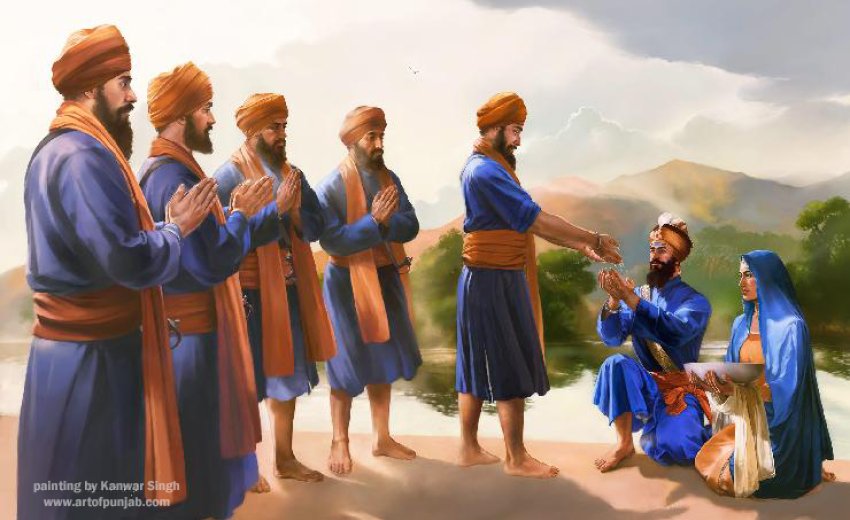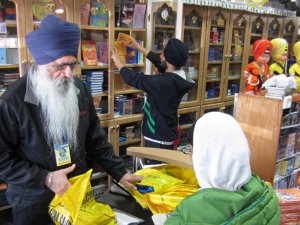
1699: The year that transformed the day of Vaisakhi from just another date on the Indian calendar into a magical presence for Sikhs all over the world.
We celebrate its revolutionary spell on our lives every year, all over the globe. I, too, have penned almost yearly paeans on and about it. Today, I will spare you the customary sermon, but leave you with some thoughts to nurture and parse. And I will be relatively brief.
We celebrate Vaisakhi 1699 as the birthday of the Khalsa. Yes, do celebrate it; but remember that newborns don’t just happen. Nine months of gestation precede a human baby’s prenatal development and birth.
What was the raison d’être for the Khalsa and how long was the gestation? The founder of the Sikh faith, Guru Nanak, initiated a monumental project of nation building that took ten generations – a little over 240 years – to complete, before 1699 marked the initiation (birth) of the Khalsa.
Why do I label Sikhi an ‘experiment in nation building?’ Because the gestational events are extremely important.
In human history, with the Balkans Punjab, the northwest territory of the Indian subcontinent we see one of the richest laboratories of genetic hybridization. Historically, we count here the local natives along with the Caucasian migration, Alexander and his Greek armies, Mongols, Mughals and a countless slew of tribal and sundry invaders and conquerors that hurtled into Punjab through the Khyber Pass – to conquer and return, stay or perish.
When Guru Nanak trod the earth over 500 years ago, Muslims were the politically dominant force in India, while the majority, Hindus, lived little better than slaves. Islam turned intolerant; the rulers began focusing on converting the Hindus -- willingly or at the point of a sword. At that time, the Hindu majority itself was rigidly divided by caste that allowed absolutely no vertical mobility. High and low castes would never break bread together, nor even sit together. Fully half the Hindus, including all women as well as low castes, were not allowed access to any religious scriptures.
A paradigm shift was necessary on a large, national scale. What is it that a people need? They struggle for freedom of religion and thought, economic hope and opportunity; participatory self governance, a sense of justice and accountability along with a common spiritual core as the underpinning of their life. But such paradigm shifts are not easy. They require more than a generation to take root and flower.
Guru Nanak started the process with sangat and pangat and raised his voice for gender equality. He also nurtured a new community of spiritual and practical living at Kartarpur, a practice that subsequent Gurus followed. By Guru Gobind Singh’s time, many new communities and townships all across Punjab had been established; for example, Guru Angad founded Khadur, Goindwal was founded by Guru Amardas, Ramdaspur by Guru Ramdas, Taran Taran and Amritsar by Guru Arjan, Hargobindpur, Kiratpur and a second Kartarpur by Guru Hargobind, Anandpur by Guru Tegh Bahadur and Kesgarh by Guru Gobind Singh. Guru Har Rai contributed ecological awareness. Mind you this is an intentionally short, incomplete list here.
Guru Angad formalized the Punjabi language. Guru Amardas organized diocesan territories for Sikh teaching to be imparted across the Indian subcontinent – an outreach program if you will. He also started the practice of egalitarian Sikh conclaves twice a year at Vaisakhi and Divali – somewhat akin to giant town hall gatherings, precursors of the Sarbat Khalsa that became formalized later.
Guru Arjan edited and compiled the collection of Sikh scriptural writings of the Gurus as the Adi Granth, and also included in it compositions of many saints and bards of the subcontinent, whether of Muslim or Hindu lineage and heritage; some being from low castes. Guru Hargobind taught us how to stand up for what is right and gave us the incomparable Meeri-Peeri doctrine of how to merge our inner and outer directed lives. By example, Guru Arjan and Guru Tegh Bahadur taught the people how put their heads on the line and die for a cause.
Thus was constructed the philosophic, social and economic infrastructure of the new greater Punjab. Each of the items that I barely listed here deserves fuller treatment. Today I am merely giving a chronological listing of bullet points.
Only then did Guru Gobind Rai gave us Vaisakhi 1699 where the first five Sikhs answered the Guru’s call for a head and became Khalsa. After being initiated by the Guru they in turn inducted Guru Gobind Rai into the Khalsa discipline as Guru Gobind Singh. The Guru then became subject to the same rules and code that regulated Sikh behavior. That should connect us to the very modern idea of the “Servant-Leader” that is routinely taught in Business Schools every day. By this time, an embryonic system of internal conflict resolution and justice was also in place.
In 1708 the Guru Granth was endowed with our entire spiritual heritage while temporal authority rested in the Sikh community acting in an awareness of its spiritual roots.
The transference to participatory self-governance and accountability was then complete. Thus was the message of Sikhi finalized that, in my view, remains unique, universal, timeless — a thinking person’s pragmatic lifestyle most powerfully expressed through its five articles of faith.
Vaisakhi 1699 had a gestation period of almost 250 years. This is how a major cultural paradigm shift is made over many generations. What we do with the idea is now our onus.
Thus was the Sikh nation built! Now Sikhs are a polyglot reality across the world. A sovereign spiritual nation without borders!
Hail Vaisakhi 2016
April 13, 2016





